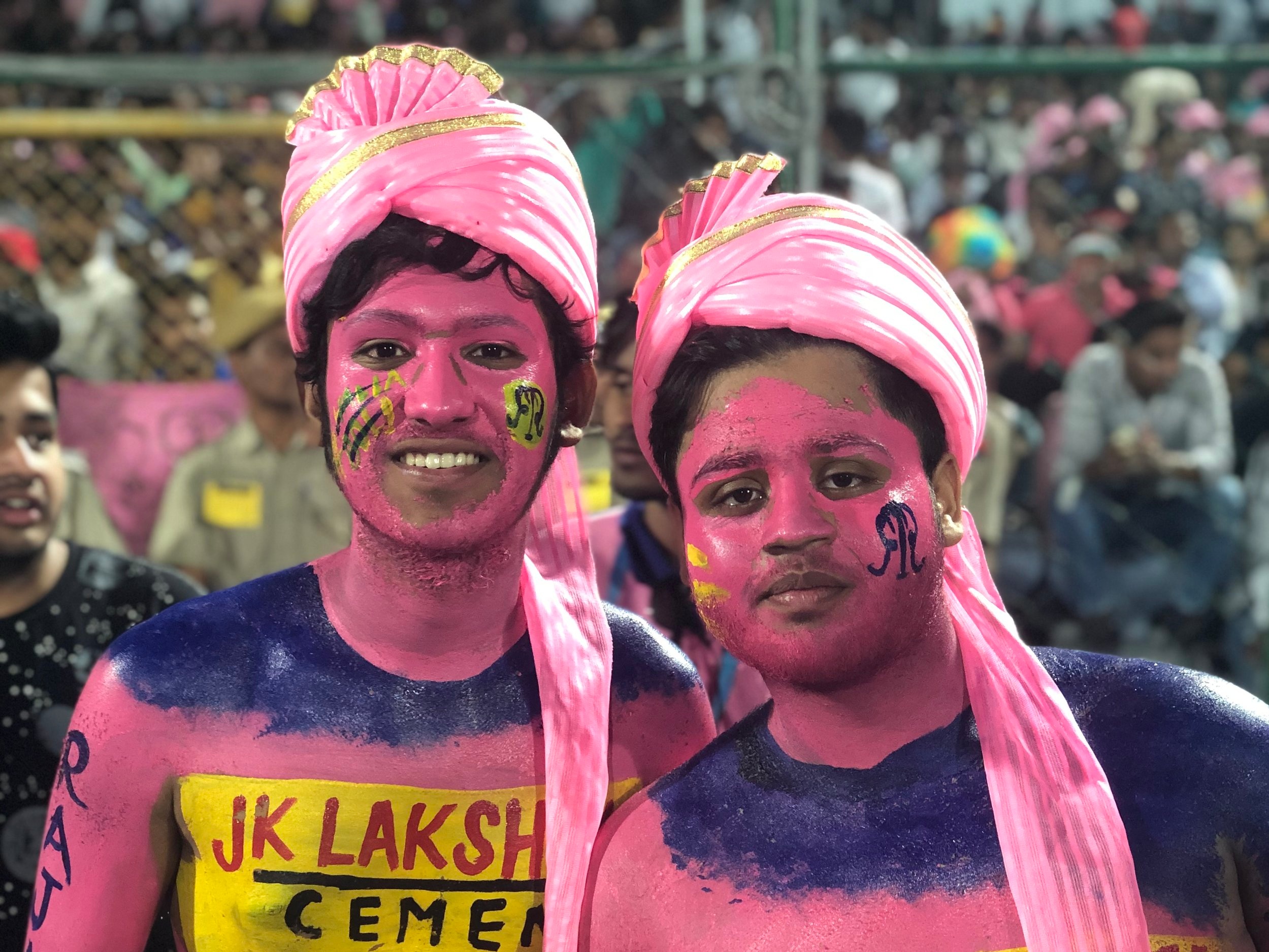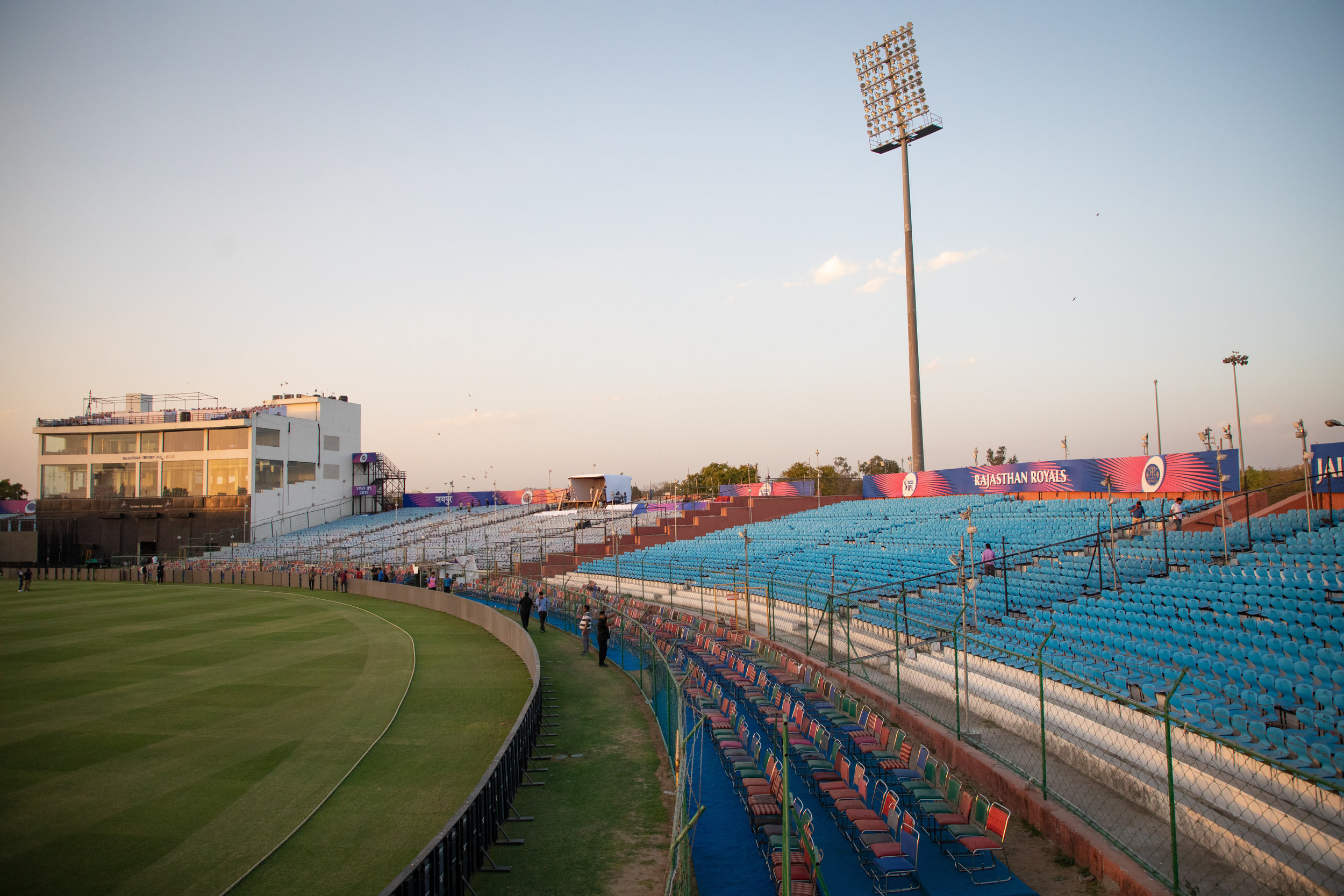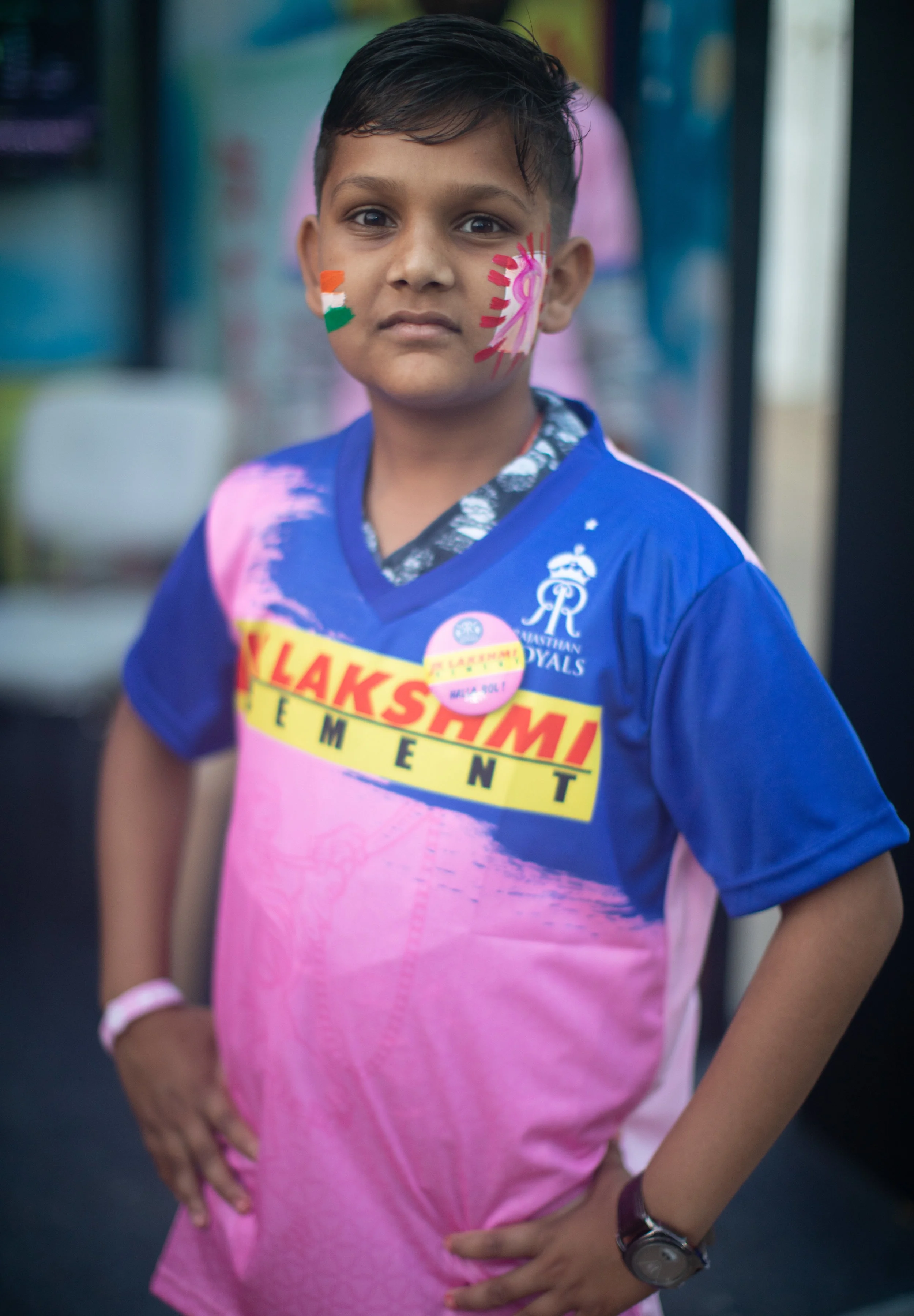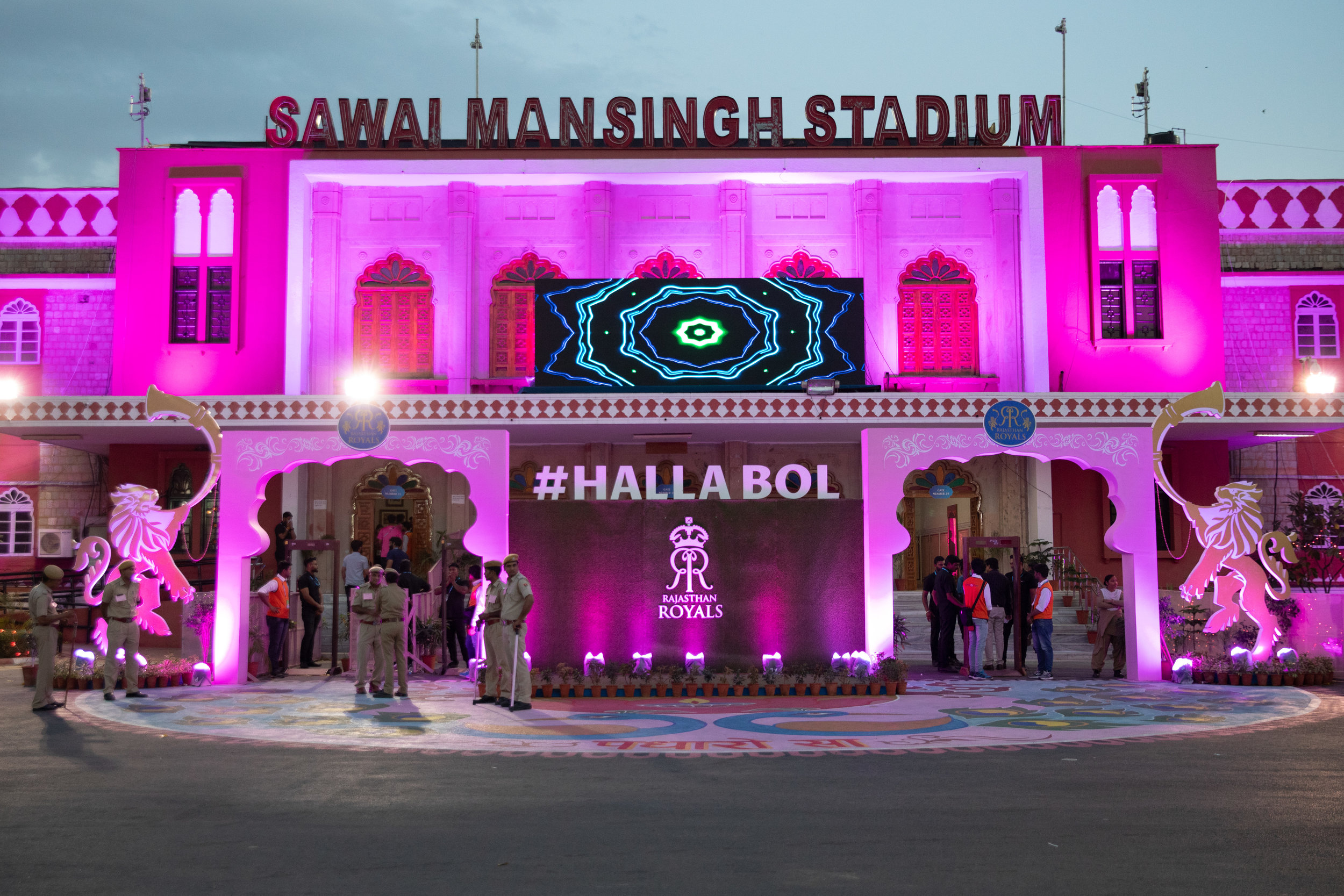The Tamasha in Jaipur: Embedded with the Rajasthan Royals
published in wisden cricket monthly on 25 april 2019 [shop link]
Departing my room in search of a breakfast dosa, I am gathered up by some hotel staff and ushered along a corridor to a service lift. As we are descending, one of the men wishes me luck for tonight’s game. I suddenly understand. I say thanks, because to be rude would be worse than to lie. The lift doors open. I am ushered through a hissing kitchen, phalanxes of outstretched arms guiding my way, and enter through a backdoor into what ten hours earlier had been a bar, but this morning is one vast breakfast buffet. To the confusion of the staff, I make for the exit, contorting myself around the imposing back of a South African security man who is explaining to a woman that no, this is a private players area, meaning no, her children can't meet Ben Stokes.
"I'm young enough, white enough, and (just about) lean enough to pass for an overseas cricketer, so I am relentlessly afforded attention I don’t deserve."
For the rest of the day, I am burdened with this odd aura of misplaced celebrity. I am at the Rajasthan Royals’ team hotel and this evening they are playing the Royal Challengers Bangalore here in Jaipur. I'm young enough, white enough, and (just about) lean enough to pass for an overseas cricketer, so I am relentlessly afforded attention I don’t deserve. As I emerge from the team’s breakfast room, a little girl runs over, looks up at me with enormous brown eyes, and says “Excuse me, sir; are you Jos Buttler?” When I inform her that no, I am not Jos Buttler, she looks crestfallen and scampers away. Immediately, she is replaced by a young man who wants a selfie. I tell him I’m not a cricketer, “just a tourist.” He doesn’t listen. We take a selfie. I look a little gaunt, the Royals’ chairman having last night insisted that I try, and then keep trying, the Sancerre.
Now unnerved by the amount of people I can see in the non-cricketers’ restaurant, I decide to delay the dosa and head for a swim. Sanju Samson is doing some gentle pool running with a coach, and I start with some laps on the other side of the chill cyan water. After being shooed away from Samson, a kid ambushes me at the end of the pool; I surface, and there is he, brandishing a pen and booklet and asking for an autograph. Once again, I explain that I am not famous, that he doesn’t want my autograph. He runs off, but a few laps later his friend does the same thing.
This keeps happening. It’s the IPL, so the match won’t start until 8pm, but by lunch I am so worn down by disappointing cute children that, despite not having held a cricket ball in a competitive setting for more than a decade, I am mimicking precisely the behaviour of the actual Royals players, sequestering myself away at the top of the hotel and awaiting the buses. I wish I’d done what they are encouraged to do by the coaching team, and sleep until midday. Outside, the Jaipur skyline quivers with heat, but in air-conditioned solitude I turn on Star Sports. Not for the first time, I find Kevin Pietersen, opining on last night's highlights with a strange pensiveness.
"RCB are captained by Kohli – he is staying on my floor, in what I assume is the room with a burly Sikh gentleman stationed outside it at all hours – and in the two days before the game, the K-word is on the air, like a mantra."
This general experience starts off as a bit of a curiosity, a minor anecdote – but by the time I leave Rajasthan it has expanded in my mind to reflect, obliquely, the heart of the IPL. Looking out from within the day-to-day life of a team franchise, you see that the IPL – to a degree that almost makes it seem like a different game to English county cricket – is a big, big deal. Everyone knows this, of course, but it's another thing to witness it. Everyone, when asked, says that yes, they like the IPL. It is never, ever not on TV (which helps it suck up a quarter of all India’s advertising spend). It is intertwined with Bollywood stars and tycoon owners, all of whom many Indians revere with none of the awkward affluent guilt of the Western middle-classes. And the IPL’s big players are bonafide rock stars. RCB are captained by Kohli – he is staying on my floor, in what I assume is the room with a burly Sikh gentleman stationed outside it at all hours – and in the two days before the game, the K-word is on the air, like a mantra. People prowl in the lobby, phones at the ready, the camera apps already visibly open. I overhear discussions of where he is: Kohli is in the gym, Kohli just got in the lift, someone saw Kohli getting in an SUV. Two different receptionists express profound disappointment that he is married (to a Bollywood star, naturally).
The strangest thing about being repeatedly mistaken for someone famous is you suddenly find yourself feeling dreadfully inadequate for not being famous. With every selfie to which I politely acquiesce, I feel even more like a pathetic non-celeb. Come six o'clock, milling in the hotel lobby, draped in the Royals’ distinctive pink, I am assaulted by eyeballs that fill me with embarrassment at the thought of just how dreadful I’d be if this instant I was thrown into a Royals net session. Pathetically, I want to tell people that I did play a game for Sussex when I was fifteen. Surely that’s better than nothing? We wait. Word gets round that the stadium is dry; myself and a well-known journalist shift a couple of sharp gin and tonics. Eventually, the team entourage is loaded onto a minibus. In front of our minibus is the team coach, bigger and pinker. I’m sat in front of the Stokes family, who are rollicking good company, and across from Joffra Archer’s girlfriend, whose Barbadian accent is so beautifully musical that it’s hard to pay attention to what she’s actually saying.
We set off. A police escort has us moving with a velocity that, by India’s traffic-choked standards, is remarkable. Along the side of the road, people are dancing and waving and singing. As we near the stadium, the numbers swell. English cricket grew out of the village, but Indian cricket has always been a thing of the city, and here they are, with the density only urban centres can generate. The Royals’ social media team are streaming on Instagram Live, and because I have a prime window seat I am given the phone to record the crowds. The people notice, and wave harder. Someone yells “Buttler!” Glancing at the screen, I notice the comments pouring in. It is pure excitement, all cricket’s staid minutiae stripped away. There are no remarks about Unadkat being dropped, or questions about whether we’re expecting dew as the evening progresses – just a stream of emojis and capitalised player names, a flood of colour and cheer.
"'The great tamasha,' James Astill has called it, tamasha being Hindi for a spectacle, a dazzling hullabaloo. An IPL season is 'like standing in a room with a glitterball spinning for six weeks,' Ish Sodhi tells me, after the game."
I am accustomed to cricket being a generally sedate thing, a game that can never quite shake a whiff of fundamental uncoolness, most loved by people prone to serious opinions about whether to bring fine leg up. This isn’t that. This is about fame, about a blend of celebrity and athletic worship that borders on an ecstatic religiosity totally alien to the English version of the game. “Cricketainment,” Lalit Modi called the IPL, when he launched it in 2008. “The great tamasha,” James Astill has called it, tamasha being Hindi for a spectacle, a dazzling hullabaloo. An IPL season is “like standing in a room with a glitterball spinning for six weeks,” Ish Sodhi tells me, after the game.
At the ground, we go from the minibus up a series of staircases to the Shane Warne gallery (no sign of the man himself, sadly). Below us is the the pink-walled home dressing room. We claim perfect seats overlooking the arm. The stadium is a low bowl, brilliant under the floodlights, writhing with pink. As in the rest of swelling, climbing India, there are cement adverts everywhere. The pitch is that perfectly flat green oval which to any cricket-lover’s eye is a thing divine. Things get busier. Music pounds, and the big screens show an endless reel of recent sixes, or “maximums” (which in the IPL account for around a quarter of all runs). The air is aswarm with insects, some of them as big as your fist. The IPL's European, skimpily dressed cheerleaders have long been controversial amongst India’s more conservative spectators – uniquely within the league, the Royals tactfully tone things down, outfitting their cheerleaders in full sleeves and leggings despite the sweltering Jaipur air. They gyrate down below us, pom-poms and blonde hair rippling.
The previous evening, on a tour of the stadium, I had seen the top of the fencing being wound with snarling barbed wire, to deter climbers. This was seen as necessary because, with Kohli out in the middle, the Royals are worried about pitch invaders. It's highly unlikely any invader would have malicious intentions; more likely, they would fall at Virat's feet and pray. But still. When Kohli comes out to bat, the crowd go wild, enjoying the excellent chantability of his name. Early in his innings, to a shortish one, Kohli leans back gingerly, like a man dodging a drunk punch, and with a cross between a late cut and a ramp shot sends the ball scurrying to the boundary, too fine for third man. In one of those examples of a charmingly dated sort of English surviving within the modern Indian lexicon, 'CRAFTY’ flashes up on the big screens. All the fans are going wild. Around me, people in pink jerseys, nominally Royals supporters, are cheering one of their bowlers being clipped for four.
This is one of the oddest things about the IPL, as it is actually enjoyed by tens of millions of Indians. While cricket is in theory a competitive sport and the IPL is in theory a tournament, most of the fans don’t actually appear to be that bothered about who wins. The team certainly care; the Royals had lost their first three games, and there was frustration and nerves amongst the management, who had assembled this selection of players at the IPL’s elaborate auction for serious money. But the fans are there not so much for the contest as for the flashes of drama, whichever side they benefit. Beneath the all the glitz and noise, it is this that makes the IPL truly unique. It is an enormous sporting event, but it is almost devoid of real tribalism. It is a wild celebration of cricketing as a collection of pure, Platonic elements. Bat, ball. Boundary, wicket. The crowd love it every time Kohli cracks one, but they also go wild when the excellent Shreyas Gopal rattles his middle stump with a googly. After a few overs, I give up trying to track their allegiance, because they only care about one thing: cricket, as a raw, roiling thing. They cheer an appeal, then they cheer the review, but then they cheer when the review is given not out. Whenever a batsman gets under one, the ball is a rising star against the smoggy, matte-black, sweltering Jaipur sky. Delirium if it ends up in the stands; delirium if it ends up in a fielder’s hands.
People are here for moments, for the rare things of the game. Whenever there is a lull in the play, attention immediately wanders. In the Shane Warne gallery, there is an almost permanent confusion about who is sitting where, with people in lanyards and the occasional invariably moustached policeman rearranging rows, bringing in new bodies. This intensifies whenever someone is nudging singles or (yawn) blocking one. Throughout, there is no etiquette around not blocking people's view as a delivery comes in. People are walking everywhere, all the time. Many are watching the game through various social live feeds. But at crunch time, they watch. When something of consequence happens, grown men go wild with an abandon that makes this uptight Brit feel obscurely jealous. It conditions you, as a viewer; Jesus, switching ends takes a long time; what am I meant to look at?
None of this is meant to sound sniffy. As a lover of Test cricket, a part of my mind thinks it has good reason to be sniffy; I don’t need to explain those reasons to you, because as a reader of Wisden Cricket Monthly, you already know them. But the truth is that I am having a bloody good time. Yes it is over-distilled, a vanishing kind of pleasure, the Vegas bender of cricket. But who doesn’t enjoy one down to cow corner ('BUTTLER SERVES IT HOT’)? Aren’t the red flashing stumps kind of cool? The millions of Indians who flood to IPL games love cricket, but they work damn hard, and they don’t have time to sit through a morning session with a hundred dot balls. India is not a country whose people can generally afford to spend a weekday afternoon nodding off over a gin and tonic while out in the middle someone shoulders arms for an over. The people who spend their Tuesday night here want cricket, distilled; and they get it (‘A ROYAL BASH!’). They are taken in by the noise and fame and lights, and why not? It might not be the enlightenment of a sadhu, but it is non-suffering of a sort. And there is, too, something bigger here: a vast, slow, two-century sweep of one country remaking another country’s game over an arc of spreading and then vanishing colonialism. In the relentless cricket coverage here, I have seen not a single mention of the start of the English county season.
Local regulations prohibit amplification after ten, and the place goes weirdly quiet, the thudding club mixes and relentlessly hyper MCs abruptly ceasing. I should be relieved, I should love that wood on wood is suddenly the loudest thing in the ground, as it was on the village greens of sleepy Sussex when I was a teenager. But I want the full tamasha. Like India’s festivals or family dinners or theologies, it is best with everything at once, with the sense flooded. The Royals are chasing down 158, and it is tense, for the handful of us who are bothered about who wins. All of the Stokes family are intelligent observers of the game; the chat is a pleasure. It is pushing midnight. Eventually the Royals need one run off the last two balls. I look back at the GM, higher up the stands, who gives a nervous thumbs up. Rahul Tripathi hooks it for six. The place erupts, amplification be damned. They would’ve done the same if he’d bottom-edged it onto his stumps. How sweet and pure, to love the game itself. We stand up and clap. People crowd the front wall to take pictures of the players shaking hands; girls scream Kohli’s name.
Those of us floating along on a river of impeccable Royals hospitality are ushered out onto the pitch. There are people in pink polo shirts everywhere. The grass is hard and flat and feels like stubble against your palm. The floodlights are blinding, like alien ships come to inspect this strange ritual of willow and leather. From haunting me on television, suddenly KP is right there, laughing with Steve Smith. I high-five the GM. The chairman and I walk out to the wicket. He is a close family friend; we link arms and he swaggers with the relief of the season’s first win. The fans are still there, waving flags, dancing. I hope that at least a few of them got a blurry shot of Kohli walking by; handsome beard, armful of tattoo. Confusing me for someone else, KP looks me plum in the eye and says “see you later.”
Throngs of people craving a glimpse of the Indian captain cause a long delay, but eventually the minibus pulls away. We get back around 1am; amazingly, there are still crowds of people, waiting on the dusty road outside the hotel to wave furiously for the ten seconds it takes the buses to turn in and disappear beyond the security gate. The artifice of fame, so like theatre; the distance between the anointed and the excluded just a few large men in earpieces deciding whether you’re allowed to walk through a door. We are back in the bar. I sit with the Stokes; we eat plate after plate of french fries. I tell them I live in Bristol. We discuss elements of the city’s recent history, reasons it has made the news. It dawns on me that 95% of the best stuff journalists gather must be off-the-record, unprintable unless one is willing to commit a proper ethical breach. What a frustrating sort of a writing life; an ocean of anecdotes that will never make it to the page.
"With all that misplaced fame earlier in the day, I am vicariously exhausted for Stokes. Eventually I realize that though I’m having a lovely time and the free Kingfisher is lovely and cold, Ben would probably rather just be with his family, not his family plus this random guy whose name he didn’t catch. I slink away."
Eventually, down the service lift from the top floor, the players start to filter down. As in the rest of life, many of them are thumbing through their phones. Ajinkya Rahane – in person as at the crease impeccably composed at all times, his eyes lit with intelligence – says hello. I say congratulations on the win. Ben joins his family and myself at our table. His brother is kind enough to introduce me, and Stokes offers a kind but practiced nice to meet you as we shake hands. It is at this precise moment that I realize I don’t have it; don’t have the tamasha spirit, in which the cricketers are Gods and to be near them is to be deliriously craved. I sit there for a good while, part of me thinking I should at least get a photo, if not mention that I’m with Wisden, try for some sort of scoop, isn’t that how a proper journalist would approach this? But I can’t do it. With all that misplaced fame earlier in the day, I am vicariously exhausted for Stokes. Eventually I realize that though I’m having a lovely time and the free Kingfisher is lovely and cold, Ben would probably rather just be with his family, not his family plus this random guy whose name he didn’t catch. I slink away.
Steve Smith is at the bar. According to Geoff Lemon’s book, part of what preceded Smith signing off on ‘sandpapergate’ was the years of exhaustion, the weight of the baggy green, and not so much an obsession with winning as a pathological and horrified fear of losing. He looks far more relaxed tonight. He looks positively serene. I decide not to interrupt that either. I go to the loo and get chatting to a young chap whose sole job appears to be dishing out hand towels. He is, it turns out, a big-time player of kabaddi, a traditional Indian game as old as the Vedas. That’s cool, I say. He agrees, but adds that “everyone just loves cricket now” – though he doesn’t seem particularly irked about this, offering one of those Indian head wobbles that I will never not love. When I get back to the bar, the well-known journalist is chatting with Smith. Fair enough.
On my last day with the Royals, I chat with Jos Buttler. He is doing a sponsor shoot in one of the hotel’s function rooms. Fully kitted out in pads and gloves, he delivers his lines against a greenscreen while a portly director offers encouraging hand signals. As with everything else in the IPL, the place is packed; there are an inexplicable amount of people just leaning against the walls, staring at Buttler with a sort of riveted laziness.
I grab ten minutes with Buttler, round a corner on a pair of stiff-backed chairs. He agrees with me that the IPL is wild, totally unlike any other sort of cricket. He has never done so much kooky sponsor work, never been so unable to walk down the street in anonymity. But he is genuinely charmed by the fans’ undying enthusiasm, and enjoys the way they come to the game first and foremost to have fun, to dance and chant and get a glimpse of their heroes. With a profundity that is deeper for being so casual, he says that three years in the IPL has helped him nurture an equanimity in the face of constant low-level chaos. And he admires the raucous, entirely un-English sort of passion that Indians bring to the game; the chants of “Dho-ni! Dho-ni!” at the Chennai game were, he said, like nothing he has ever heard in a cricket ground.
"Silhouettes move around in a cocoon of cricketing celebrity to which I was briefly admitted. It’s okay, to have been spat back out. The tamasha is more real from the outside. I catch myself wishing I had taken a selfie with Stokes."
That evening – ahead of a 6am flight to Assam, where my Indian half-uncles will drive my tennis ball leg spin into the lemon trees at the edge of the tea gardens – I sit down in my hotel room and write all this up. It is very quiet; I wish it was the night before. Behind me, across the way, I can see the pink walls of the team room, a big wood-floored space dotted with bean bags, two ping pong tables, a pool table, table football, a PS4 alcove, and various other excellent ways for young men to not get bored. Silhouettes move around in a cocoon of cricketing celebrity to which I was briefly admitted. It’s okay, to have been spat back out. The tamasha is more real from the outside. I catch myself wishing I had taken a selfie with Stokes.
They will all go and do it all again in a few days, in the noise and the heat and the total entertainment. The glitterball will spin for five more weeks yet. A sweet hot mood hovers over the Royals camp and its concentric rings of fandom and television cameras; a weird cross between a travelling circus and a finely honed warrior unit. I was lucky to be amongst it, despite being neither famous nor capable of comfortably ingratiating myself with the famous.
It is night again. Over Jaipur, a hazy moon hangs. On TV, Chennai are chasing Mumbai’s 170. Bat, ball. Boundary, wicket. I watch on mute. The crowd are dancing; when the camera finds them, they dance harder.






